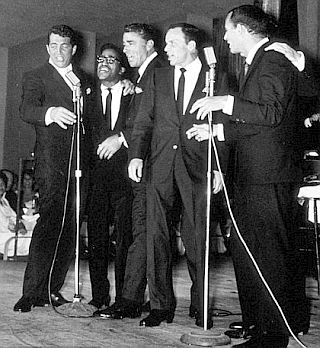
The Rat Pack on stage together in a 1960s' performance.
The “Rat Pack” was a nickname for a coterie of Hollywood stars and Las Vegas club entertainers that included Frank Sinatra, Dean Martin, Sammy Davis, Jr., Joey Bishop and Peter Lawford. For a time in 1960, this group and some of their friends were dubbed “The Jack Pack” when they helped the Kennedy-for-President campaign.
Through the early 1960s, Sinatra and his Rat Pack reigned supreme in contemporary culture; they became the “cool guys” of their generation. They brought record-breaking crowds to the Las Vegas nightclub scene and made millions for Hollywood’s box office through the movies they made.
The Rat Pack’s network of contacts, friends, and business partners ranged across Hollywood, Las Vegas, and beyond, including movie stars such as Tony Curtis, Marilyn Monroe, Janet Leigh, Angie Dickinson, and Shirley MacLaine, and also some underworld figures such as Sam Giancana of Chicago.

“Rat Pack” members early 1960s, from left: Frank Sinatra, Dean Martin, Sammy Davis, Jr., Peter Lawford and Joey Bishop.
Part 1 of the story covers Rat Pack history and the group’s involvement with the 1960 Kennedy campaign, up to and including John F. Kennedy’s election in November 1960. Part 2 of the story picks up here as plans for the 1961 Kennedy inauguration festivities are being made. This part of the story will also cover Frank Sinatra’s falling out with JFK and the Kennedy family during the early 1960s, as well as what became of various Rat Pack members and friends and Kennedy family members in the years following the Kennedy election.
Washington Gala
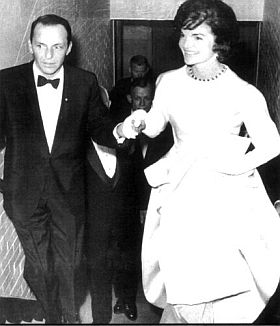
Jan 1961: Frank Sinatra escorting Jackie Kennedy to her box at the National Guard Armory for a pre-inaugural gala staged by Sinatra to help pay off JFK & Democratic Party campaign debt.
Among the performers and notables Sinatra and Lawford would gather for this event were: Harry Belafonte, Milton Berle, Nat King Cole, Tony Curtis, Janet Leigh, Ella Fitzgerald, Gene Kelly, Frederic March, Ethel Merman, Jimmy Durante, Mahalia Jackson, Bette Davis, Laurence Olivier, Leonard Bernstein, Fredric March, Sidney Poitier, Bill Dana, Kay Thompson, Roger Edens and others.
Sinatra was responsible for personally recruiting many of the stars, some flying in from filming and performing locations abroad. He and Lawford also convinced several Broadway producers to shut down for one night so actors such as Anthony Quinn, Ethel Merman and Laurence Olivier could attend.
One account had it that Sinatra personally bought out the theater tickets for the performances of the Broadway plays in conflict so the those actors could partake in the Kennedy gala.
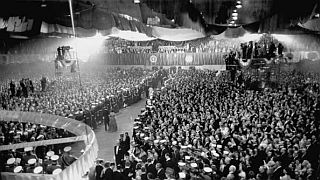
National Armory in D.C. hosted two inaugural events: the Pre-Inaugural Gala (Jan19th) & Post-Inaugural Ball (Jan 20th).
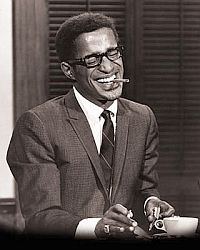
Sammy Davis, Jr., 1960s.
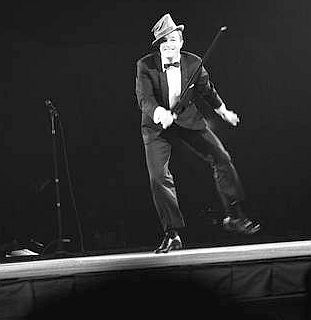
Gene Kelly performing at JFK gala, January 19, 1961.
Gene Kelly danced; Sydney Poteir read poetry, and Pat Suzuki sang. Kelly sang “The Hat Me Dear Old Father Wore” and did an amazing dance routine. Fredric March did a recitation invoking God’s help to “give us zest for new frontiers, and the faith to say unto mountains, whether made of granite or red tape: Remove.”
Bill Dana, famous in that era for portraying a fictional Chicano character known as José Jiménez, did a well-received comic routine with Milton Berle. Nat King Cole sang and so did a young, 34 year-old Harry Belafonte, whose 1956 Calypso album had become the first long-playing album in history to sell over one million copies.
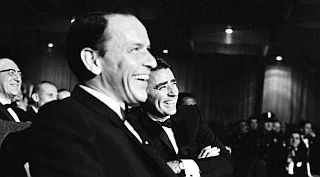
Frank Sinatra & Peter Lawford enjoy a lighter moment at the 1961 gala for President-elect John F. Kennedy.
– Todd Purdum “High Hopes,” was also used in this segment, now reworked by Sinatra with new lines that included: “Jack and Lyndon B /… Let’s follow their lead / They’re the men that our America needs!”
Todd Purdum, writing a Vanity Fair retrospective on the famous JFK gala 50 years later, summed it up this way: “It was an only-in-America blend of high culture and low comedy, of schmaltz and camp, and it may have marked the moment when popular entertainment became an indispensable part of modern politics.” In fact, Bette Davis said as much during the show in part of skit she did, reading from a script by radio dramatist Norman Corwin: “The world of entertainment—show-biz, if you please—has become the Sixth Estate…”
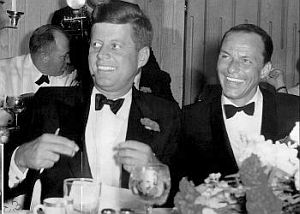
JFK with Frank Sinatra at the pre-inaugural gala, Jan 19, 1961, the night before JFK’s formal inauguration.
Of Sinatra’s role in the gala Kennedy said, “You can not imagine the work he has done to make this show a success.” Kennedy called Sinatra “a great friend,” and added: “Long before he could sing, he used to poll a Democratic precinct back in New Jersey. That precinct has grown to cover a country, but long after he has ceased to sing, he’s going to be standing up and speaking for the Democratic Party, and I thank him on behalf of all of you tonight.”
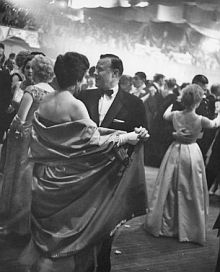
1961: Inaugural dancing at the Armory.
JFK’s Late Night
Even though it was nearly 1:30 a.m. when the gala ended, and Jackie Kennedy had long since gone home as she was still recovering from the Cesarean birth of John Jr., JFK went to another party that night given by his father, Joseph Kennedy, at Paul Young’s restaurant in downtown D.C. JFK didn’t get home until 3:30 a.m.
However the next morning, Inauguration Day, Kennedy was up at eight, reviewing his speech and preparing for a full slate of official and ceremonial meetings with outgoing President Dwight D. Eisenhower, and then on to Capitol Hill for his swearing in and one of the more memorable inaugural speeches in U.S. history.
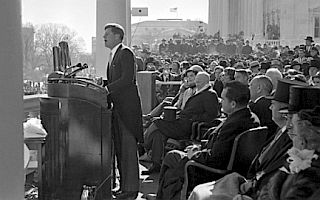
President John F. Kennedy delivering his inaugural address at the Capitol in Washington, D.C., January 20, 1961.
The Sinatra File
Following the inauguration, the ties between Frank Sinatra and the Kennedy’s – especially those involving JFK and the White House – would gradually become strained and eventually would be severed. But this would not occur for another year or so.
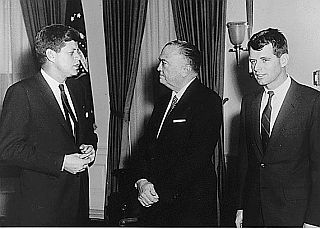
FBI director, J. Edgar Hoover, center, meeting with JFK and Attorney General Robert Kennedy, January 1961.
But in February 1961, within weeks of JFK’s inauguration, FBI Director J. Edgar Hoover sent a pointed memo to the new U.S. Attorney General, Robert F. Kennedy. The memo detailed Sinatra’s extensive connections to organized crime figures. Robert Kennedy would later impress upon his brother, the President, that he needed to distance himself from Sinatra.
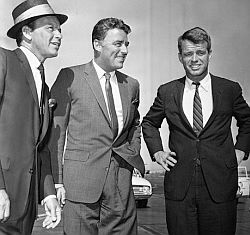
Frank Sinatra, Peter Lawford & Robert Kennedy wait for helicopter en route to a Cedars-Sinai Hospital charity event in Hollywood, July 1961.
Then, in late September 1961, ten months after the election, Joe Kennedy threw a thank-you party for Frank Sinatra at the family’s Hyannis Port, MA compound. At that point, JFK as president was still talking with Sinatra, as Sinatra would approach the president during the Hyannis Port visit to ask for a small favor.
Screenwriters in Hollywood had come to Sinatra about starring in a film, The Manchurian Candidate, based on a 1959 novel by Richard Condon.
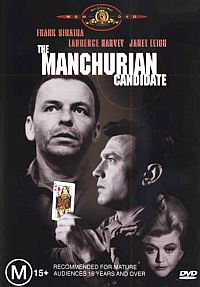
Frank Sinatra sought JFK’s help to lobby Arthur Krim to make this film.
Despite Kennedy’s help on the Manchurian Candidate, Sinatra’s access to the President and the White House would soon be ending. Later in the fall of 1961, Sinatra visited the White House as part of a larger group that included Peter Lawford and others. And during that year, press Secretary Pierre Salinger had been questioned by members of the press about Sinatra’s relationship with the president. The inner circle around Kennedy – including Robert Kennedy and the President himself – became less comfortable having Sinatra around the White House. But soon, J. Edgar Hoover’s FBI would provide some additional information on Sinatra.
Rat Pack Popularity
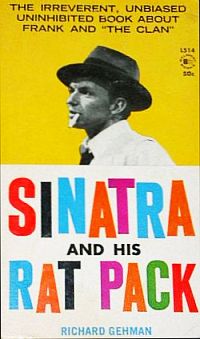
Richard Gehman’s 1961 book helped to popularize the term “Rat Pack.”
A writer from Lancaster, Pennsylvania named Richard Gehman published a paperback volume with Belmont Books in New York titled, Sinatra and His Rat Pack. The book sold reasonably well and went into at least three printings according to one source.
In the fall that year, a late night talk show hosted by David Suskind featured a Rat Pack roundtable on one of its shows with a mix of journalists and Hollywood celebrities who debated the Rat Pack’s merits and maladies. Even a New Yorker cartoon appeared with a psychiatrist addressing the concerns of a middle-aged man lying on the treatment couch, with the psychiatrist saying: “What makes you think Frank Sinatra, Dean Martin and all that bunch are so happy?”
There were also continued stage and club performances of the Rat Pack as a group, or in various combinations. Work on films with one or more members of the group continued as well, and Sinatra had a film or two of his own. The Devil at Four O’Clock, a volcano disaster film with Sinatra and Spencer Tracey came out in October 1961. Sinatra’s music continued to be popular. Dean Martin, Sammy Davis, Joey Bishop and Peter Lawford would have their notices as well.
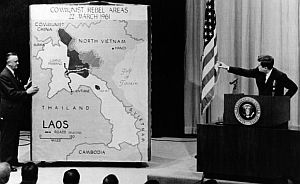
President Kennedy points to map of Laos at press conference in March 1961.
Stay At Frank’s?
As JFK’s presidential schedule for early 1962 was being plotted out, it was revealed he would be making a trip west to California in March of 1962. Early on, it was decided Kennedy would have an overnight visit at Frank Sinatra’s Palm Springs estate on March 24th, 1962. This planned JFK visit became a big event for Sinatra; a very prideful moment – much more than the pre-election partying the two had shared.Sinatra went all-out for the anticipated JFK visit – remodeling the house, adding new cottages, extra rooms, communications gear, and more. . . He even had a helicopter landing pad installed. This was now the President of the United States who was coming to stay overnight. Sinatra had initially built this Palm Springs residence in 1954. It included a main house, a movie theater, guest houses, a barbershop/sauna, two swimming pools, tennis courts, and a personal art studio. But now, he would make improvements.
Sinatra went all-out for the anticipated JFK visit – remodeling the house, adding new cottages, extra rooms, communications gear, and more to accommodate a president and his staff. He even had a concrete heliport landing pad installed. But within days of the planned visit – on March 22nd, two days ahead of the planned arrival at Sinatra’s – Peter Lawford was told by JFK and Bobby Kennedy to inform Sinatra that the President would not be staying at Sinatra’s place. Lawford tried to convince the President and Bobby not to cancel the visit, to no avail. It was then arranged that the President would stay at singer Bing Crosby’s place. Lawford then called Sinatra, fabricating a story about how Sinatra’s place was more open and more vulnerable and that the Secret Service had instead approved Bing Crosby’s “more secure” place, backing up against a mountain. Sinatra was stunned by the news, and tried appealing to Bobby Kennedy with no success. At one point, Sinatra reportedly took a sledge hammer to the heliport he had built to vent his frustration, and he was quite unforgiving of Lawford and others even remotely connected to the cancellation. From that point on, Sinatra and JFK pretty much parted ways.
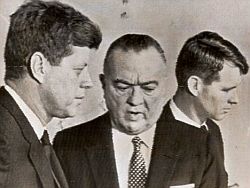
JFK, J. Edgar Hoover & Robert Kennedy.
“Happy Birthday”
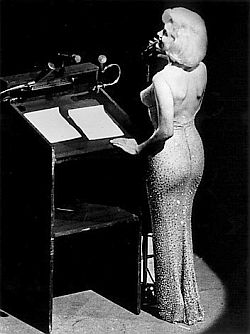
Marilyn Monroe sings “Happy Birthday, Mr. President,” May 19, 1962. Photo, UPI.
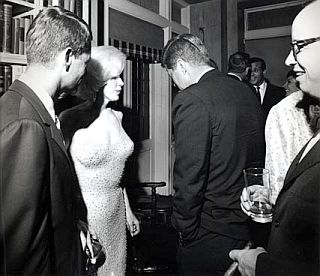
Robert F. Kennedy, Marilyn Monroe, and John F. Kennedy in rare photo taken at private “after party,” May 19, 1962. Advisor Arthur Schlesinger, with glasses, shown at right. Photo, Cecil Stoughton
Frank Sinatra, not long after the President’s cancelled overnight visit, began a world concert tour in a dozen or more cities to raise money for various children’s charities. On that trip, Sinatra did concerts in China, Israel, Greece, Italy, London, Los Angeles, Milan, Tel Aviv and Japan and raised more than one million dollars for various benefits. He returned to the U.S. in late June 1962.
Marilyn’s Fall

Marilyn Monroe in happier times with Frank Sinatra & club manager Bert Grober, Cal-Neva Resort, 1959. Photo: D. Dondero, Reno Gazette.
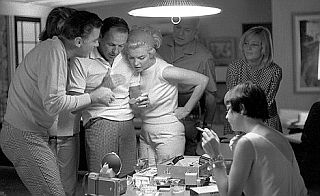 Marilyn Monroe, center, at Peter & Pat Lawford’s home in 1960-61, with Peter Lawford left and Frank Sinatra next to Monroe looking at a photograph. May Britt is standing at right. |
 Patricia Kennedy Lawford, now visible in another photo from that same time, is seen standing at left. Seated woman may have been Shirley MacLaine. |
Other accounts of that weekend at the Cal-Neva report that Dean Martin and Monroe’s former husband, baseball great Joe DiMaggio, were also at the resort. DiMaggio had never been happy about some of Marilyn’s Hollywood friends. Still other accounts have Peter Lawford telling Monroe at that point that all communication with JFK and Bobby Kennedy was to be cut off. Monroe reportedly had been upset over some things JFK had said to her in private, and she had also seen Robert Kennedy. Monroe that summer was also working on the film Something’s Got to Give, which was never finished.
August 1962
After the Lawford’s returned home from their weekend visit with Sinatra, Peter Lawford called Monroe on August 4, 1962, concerned about her health. He found that she was still not well, sounding quite depressed. He later tried calling her again but couldn’t get through. He then thought about going directly to her home. However, he was advised, that as the President’s brother-in-law, he should not go there.
On August 5, 1962, Monroe was found dead in her Brentwood home. She was 36 years old. Her death was ruled to be “acute barbiturate poisoning” by Los Angeles coroner Dr. Thomas Noguchi and listed as a “probable suicide”.
Late 1962
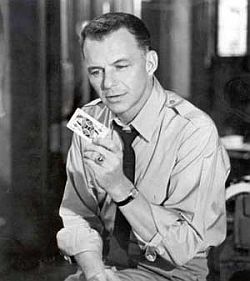
Scene from “The Manchurian Candidate,” in which Frank Sinatra, as Korean War veteran Bennett Marco, attempts to help a fellow veteran who's been brainwashed.
By October 16th, a day the New York Yankees would beat the San Francisco Giants in game seven of the 1962 World Series, Kennedy was shown new U-2 photos revealing fully-equipped missile bases capable of attacking the U.S. with nuclear warheads. Plans were drawn up for a possible U.S. invasion of Cuba. A massive mobilization of military hardware began, and more than 150,000 active duty troops from the Marines, Army and Air Force were either positioned in Florida or put on high alert, while additional reservists were ordered to report for duty.
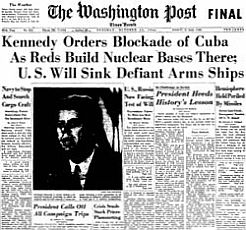
Cuban “missile crisis” headlines, Oct 1962.
The President also stated that any nuclear missile launched from Cuba would be regarded as an attack on the United States by the Soviets and he demanded the missiles be removed from Cuba.
The “missile crisis,” as it came to be called, was the closest the world ever came to nuclear war in the 1960s. In the end, Soviet leader Nikita Khrushchev turned his ships around. The Soviets agreed to dismantle the weapon sites and, in exchange, the U.S. agreed not to invade Cuba and remove its missiles from Turkey.
1963
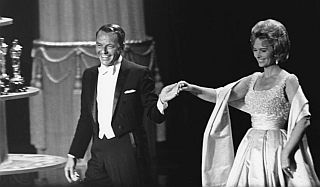
April 1963: Frank Sinatra hosts the Academy Awards ceremony, shown here escorting actress Donna Reed.
Sinatra also recorded a new LP in April 1963, titled Sinatra’s Sinatra. This was an album of Sinatra songs from the 1940s and 1950s, updated with new versions for Sinatra’s own label, Reprise. The album did quite well, reaching No. 9 on the Billboard and U.K. album charts. The film Come Blow Your Horn, in which Sinatra starred, was also a major box office success that summer, garnering him a Golden Globe acting nomination.
President Kennedy that spring, among other things, visited Hollywood briefly for a Democratic Party fundraiser. This affair, however, was a limited VIP gathering of about one hundred of Hollywood’s biggest stars, among them: Marlon Brando, Cary Grant, Burt Lancaster, Charlton Heston, Gene Kelly, Dean Martin, Rock Hudson, Jack Webb and others. “Instead of offering a formal speech the president table-hopped, impressing his guests with a wide-ranging knowledge of movies in general and their careers in specific,” explains Alan Schroeder of Northeastern University who has written on the presidency and Hollywood. Kennedy was a life-long fan of Hollywood, and remained intrigued about its inner working and even its gossip.

June 1963: JFK delivering his famous speech in West Berlin.
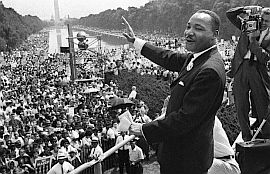
August 1963: Martin Luther King on the Mall in Washington, DC, “I have a dream.”
Elsewhere, however, Frank Sinatra had his problems. In Las Vegas, Nevada, the state’s Gaming Control Board recommended in September 1963, that Sinatra’s casino gambling license be revoked for allowing Chicago crime boss Sam Giancana to visit Sinatra’s part-owned Cal-Neva Lodge at Lake Tahoe. The Gaming Control Board had a published “List of Excluded Persons” who were not allowed in casinos even as customers, and Giancana was on that list. Sinatra never understood the stigma of his friendship with Giancana and others like him, as he had been friends of theirs since the 1940s. Still, Sinatra had to give up his casino license and sell his interests in the Cal-Neva and the Sands. ( Later, however, Sinatra would have his Las Vegas bona fides restored in 1981 when he applied for license as an entertainment consultant at Caesars Palace, listing President Ronald Reagan as a character reference and having Gregory Peck testify on his behalf. The Gaming Commission voted their approval, 4-1 ).
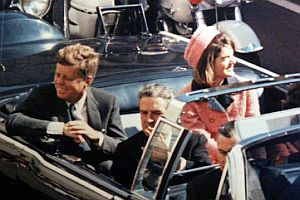
Nov 22, 1963: JFK, Jackie, and Texas Governor John Connolly in Dallas moments before shots were fired.
Within hours of the shooting, police arrested 24 year-old Lee Harvey Oswald as the prime suspect. Vice President Lyndon B. Johnson – with a shaken Jackie Kennedy beside him aboard Air Force One – was sworn in as President. The nation went into deep shock and weeks of mourning.
An Era’s End
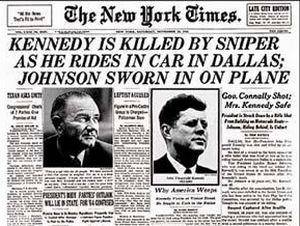
New York Times front page, November 23, 1963.

Washington Post front page, Nov 23, 1963.
For the Rat Pack, Kennedy’s death also marked the end of an era. Rat Pack hijinks-type entertainment would gradually fade from the scene. By 1964, with the arrival of the Beatles, the music had changed as well. Yet Frank Sinatra, for one, would hold his own.
In 1965, Sinatra turned 50, but he still had years of hit music ahead of him. In that year alone, he recorded the retrospective album, September of My Years and starred in the Emmy-winning television special Frank Sinatra: A Man and His Music. In early 1966 he scored a recording hit with the blockbuster single, “Strangers in the Night,” a song that would later win three Grammy awards.
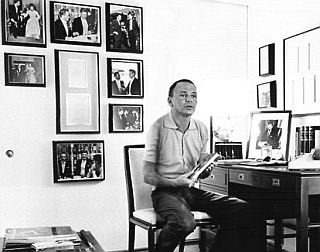
Frank Sinatra shown in a room at his home that includes framed photos and other memorabilia from his Kennedy-era years. Date unknown.
Sinatra Politics II
In the 1968 national elections, during the Democratic presidential primaries, a number of Hollywood celebrities became engaged in those contests, generally hoping to change national policy as the Vietnam War divided the country. Paul Newman and others were backing Democratic candidates such as Senator Eugene McCarthy, Bobby Kennedy, or Hubert Humphrey, then Vice President to incumbent Lyndon Johnson who had decided not to run for re-election in a shocking announcement. McCarthy appeared to have the early momentum, then Bobby Kennedy jumped in and was headed for victory before his tragic assassination in June 1968. However, Kennedy had done quite well with Hollywood supporters. But one entertainer noticeably absent from the Kennedy bandwagon was Frank Sinatra.

Frank Sinatra backed Hubert Humphrey in the 1968 election.
Shift to Republicans
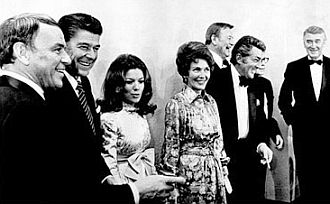
Jan. 1971: Frank Sinatra with California Governor Ronald Reagan, Vikki Carr, Nancy Reagan, Dean Martin, Jack Benny (obscured), John Wayne & Jimmy Stewart.

Frank Sinatra’s April 1973 performance at the Nixon White House on Red Cab Records, 2010.
“The older you get the more conservative you get,” he explained to his daughter Tina, who at the time was working for the Democratic candidate George McGovern. Sinatra’s old Rat Pack pal, Sammy Davis, Jr., also supported Nixon in 1972.
In April 1973, a time when Sinatra’s “comeback album” Ol’ Blue Eyes Is Back had appeared, he was invited by President Richard Nixon to perform at the White House, the first president to do so. Following a state dinner for Italian Prime Minister Guiulio Andreotti, Sinatra performed a number of his songs for more than 200 guests in the East Room of the White House.
During Nixon’s presidency, Sinatra visited the White House several times. He also supported Nixon’s moves to recognize the People’s Republic of China.
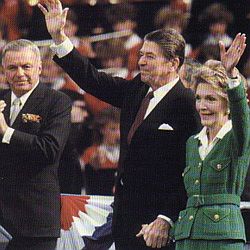
Frank Sinatra, left, campaignng with Ronald & Nancy Reagan, 1984.
For Ronald Reagan
By 1979, when Ronald Regan ran for president, Sinatra campaigned for him, saying at one point he worked harder for Regan than he had since 1960 when he backed Jack Kennedy. And as Sinatra had done for Kennedy 20 years earlier, in January 1981, he now also produced Reagan’s Inaugural Gala, lining up a slate of performers that included Johnny Carson, Bob Hope, Dean Martin and Charlton Heston. “I don’t view the inaugural as political,” he said when asked about producing Reagan’s show. “If Walter Mondale had won, and if he had asked me to do [his gala], I’d have been there.” Sinatra also campaigned for Regan in 1984. In fact, during October and early November of that election season, Sinatra went to Chicago, Cincinnati, Cleveland, Hartford, Westchester, New York, Washington, D.C., Sacramento, and San Diego doing Republican receptions and/or fundraisers on behalf of Reagan.
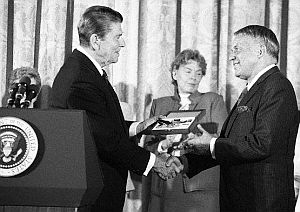
May 23, 1985, Sinatra received the Presidential Medal of Freedom from President Ronald Reagan. Cabinet member Jeane Kirkpatrick is seen in the background.
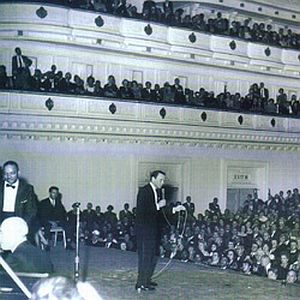
Flashback: Frank Sinatra, January 1961, at Carnegie Hall benefit concert for the Southern Christian Leadership Conference, with Sy Oliver (left) conducting. Dean Martin and Sammy Davis also participated.
On Race…
On July 4, 1991, Sinatra, at the age of 75, wrote an opinion piece that ran in the Los Angeles Times and summed up one of his life’s major social concerns – race relations:
“[W]hy do I still hear race- and color-haters spewing their poisons?… Why do I still flinch at innuendos of venom and inequality? Why do innocent children still grow up to be despised? Why do haters’ jokes still get big laughs when passed in whispers from scum to scum? …Why do so many among us continue in words and deeds to ignore, insult and challenge the unforgettable words of Thomas Jefferson, who drafted the Declaration of Independence’s promise to every man, woman and child — the self-evident truth that all men are created equal?”
Sinatra passed away in 1998, ten years before the election of Barack Obama. Yet, had he been around at the time, he might well have returned to the Democrats and supported Obama.
_________________________________________
Rat Pack Postscript
1960s-2008
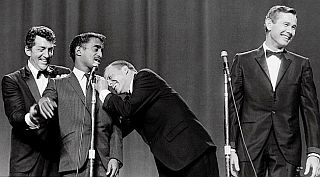
1965: Rat Packers D. Martin, S. Davis & F. Sinatra with Johnny Carson subbing for J. Bishop in St. Louis.
As individual performers, however, the Rat Packers of the 1960s pretty much went their separate ways in later years. And for the most part, each fared moderately well, at least initially.
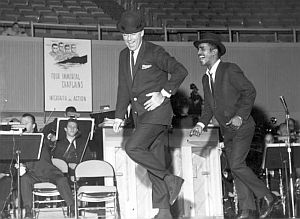
Feb 7, 1960: Peter Lawford & Sammy Davis, Jr. on stage at Four Chaplin’s Benefit, Las Vegas Convention Center. Photo, University of Nevada, Las Vegas.
But things began unraveling for him after his divorce from Patricia Kennedy in February 1966. They had four children together.
Lawford, who liked the ladies and partying, married three more times after Pat Kennedy, each time to a woman half his age.
Lawford died at Cedars-Sinai Medical Center in Los Angeles on Christmas Eve 1984 of cardiac arrest complicated by kidney and liver failure after years of drug and alcohol abuse.
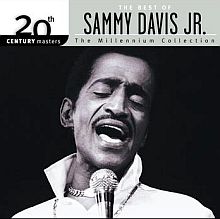
Best of Sammy Davis collection on 20th Century Masters CD, 2002.
Sammy Davis had continued success in Las Vegas through the 1960s, as well as in film and on stage. During his career, Davis appeared in 39 movies, four Broadway plays, and released some 47 albums and 38 singles. His 1962 song, “What Kind of Fool Am I,” was Grammy-nominated for both song of the year and best male solo performance. In the Broadway musical Golden Boy of 1964 he received a Tony nomination for best actor. He would also host his own TV show on NBC in 1966 and had top music hits, such as “I’ve Gotta Be Me” in 1968-69 and “Candy Man” in 1972. Davis also had film and TV roles through the 1970s and 1980s. After reuniting with Sinatra and Dean Martin in 1987, Davis toured with them and Liza Minnelli internationally. Davis, who suffered from throat cancer, succumbed to the disease in May 1990. He was 64 years old. At his death, Davis was in debt to the IRS and his estate was the subject of legal battles. On May 18, 1990, two days after Davis’ death, the neon lights of the Las Vegas strip were darkened in tribute to him.
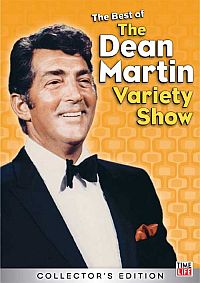
DVD cover for collection of Dean Martin’s TV shows, 1965-1974.
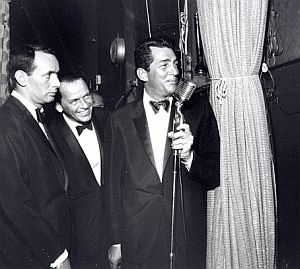
Joey Bishop, Frank Sinatra, and Dean Martin during a Rat Pack stage act in the 1960s.
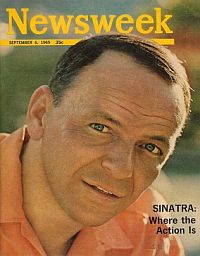
Frank Sinatra on the cover of Newsweek, September 6, 1965.

Frank Sinatra on 2008 U.S. postage stamp.
Sinatra flirted with retirement briefly in the early 1970s, but by 1973 had a gold-selling album and a television special. He also returned to live performing Las Vegas and elsewhere. Still recording in his later years, he recorded Duets in 1993, an album of old standards he made with other prominent artists which became a best seller. Sinatra died May 14,1998, he was 82 years old. Included among the many honors he received over the years were: Kennedy Center Honors in 1983, the earlier-mentioned Presidential Medal of Freedom in 1985, and a Congressional Gold Medal in 1997. Sinatra was also the recipient of eleven Grammy Awards during his career, including the Grammy Trustees Award, the Grammy Legend Award and the Grammy Lifetime Achievement Award. The U.S. Postal Service issued a 42-cent stamp in his honor in May 2008.
Other stories at this website that deal with and/or touch upon the life of Frank Sinatra include: “The Sinatra Riots, 1942-1944,” “Ava Gardner, 1940s-1950s,” and “Mia’s Metamorphases, 1966-2010.” Other Kennedy family stories include: “Kennedy History–12 Stories: 1954-2013,” “JFK’s 1960 Campaign,” and “JFK, Pitchman?, 2009.” Beyond these, see also the various category pages, archive, or the Home Page for additional story choices.
Thanks for visiting — and if you like what you find here, please make a donation to help support the research and writing at this website. Thank you. —Jack Doyle
|
Please Support Thank You |
____________________________________
Date Posted: 21 August 2011
Last Update: 29 May 2017
Comments to: jdoyle@pophistorydig.com
Article Citation:
Jack Doyle, “The Jack Pack, Pt. 2: 1961-2008,”
PopHistoryDig.com, August 21, 2011.
____________________________________
Sources, Links & Additional Information
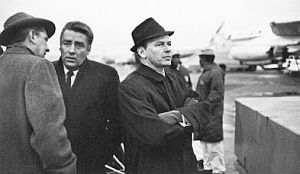 Jan 1961: Peter Lawford & Frank Sinatra at airport en route to work on JFK inaugural show. Photo, Phil Stern. |
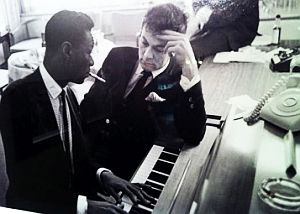 Nat King Cole and Tony Curtis preparing for show at JFK inauguration. Photo, Phil Stern. |
 January 1961: Frank Sinatra rehearsing for JFK Inaugural Gala. Photo, Phil Stern. |
 Jan. 19, 1961: Jackie Kennedy stepping out into the snowfall en route to Inaugural Gala with JFK behind her. |
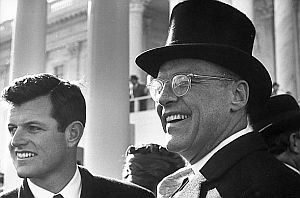 Jan 20, 1961: Ted Kennedy & family patriarch, Joseph P. Kennedy, on JFK Inauguration Day. (Paul Schutzer). |
 Jan 20, 1961: Frank Sinatra, JFK & Peter Lawford at one of the inaugural balls. Photo, Phil Stern. |
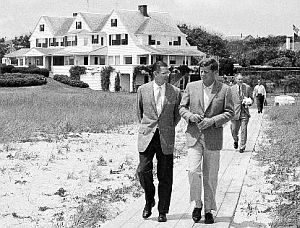 1961: President Kennedy walking with Defense Secretary Robert McNamara at Hyannis Port, MA. |
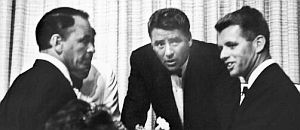 July 8, 1961: Frank Sinatra, Peter Lawford and U.S. Attorney General, Robert Kennedy attending benefit dinner for Cedars-Sinai Hospital at Beverly Hilton, L.A. |
 May 19, 1962: Peter Lawford introducing Marilyn Monroe at JFK’s birthday gala in New York city. |
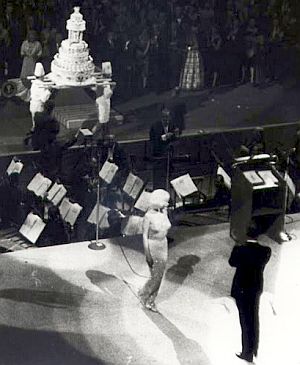 JFK birthday cake being carried into hall as Monroe & Lawford leave stage. Photo, Life/Bill Ray. |
 August 6, 1962: New York Daily News front page, reporting on the death of Marilyn Monroe. |
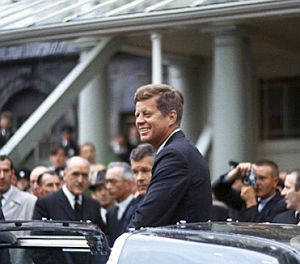 June 27, 1963: President John F. Kennedy in Ireland. |
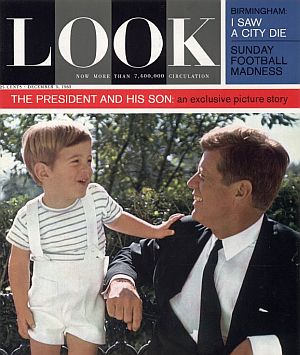 Dec. 3, 1963: Look magazine ran a special picture story on JFK & his son shortly after the president’s death. |
“Sinatra To Appear With Other Stars At Inaugural Gala,” Washington Post/ Times Herald, December 3, 1960, p. A-10.
“Sinatra Vetoes Planners, Insists on Giving Party,” Washington Post / Times Herald, December 23, 1960, p. B-7.
Vernon Scott, “Sinatra Is Sartorial Star,” Washington Post/Times Herald, Dec. 31, 1960, p. B-4.
Maxine Cheshire, “Frankie Would Have Done The Same Thing for Nixon,” Washington Post/Times Herald, Jan. 7, 1961, p. D-6.
“People,” Time, Friday, January 13, 1961.
“Frank and Ella Win Jazz Poll,” Washington Post/Times Herald, Jan. 13, 1961, p. B-12.
James Bacon, “Sinatra Show Set for Kennedy Inauguration; Actor Hopes Event Planned by Himself and Clan Will Cut Democratic Deficit,” Los Angeles Times, January 15, 1961, p. F-13.
Marie Smith, “There Will Be F-I-V-E (Count ‘Em) Five Balls,” Washington Post / Times Herald, January 18, 1961, p. C-1.
Richard L. Coe, “Friendly, Competent Rehearsal Shows Pros Are at Work on Gala,” Washington Post / Times Herald, January 19, 1961, p. D-1.
Don Shannon, “Sinatra’s Clan Out to Raise Million Tonight,” Los Angeles Times, January 19, 1961, p. 2.
Russell Baker, “Show People Help Democratic Coffers,” New York Times, January 20, 1961, p. 1.
“Snow Added Frosting To All That Gala Glitter,” Washington Post/Times Herald, Jan. 21, 1961, p. B-12.
“Joey to Emcee Kennedy Dinner,” Washington Post/Times Herald, Feb. 25, 1961, p. A-17.
“Rare and Unseen: JFK’s Inauguration,” Photo Gallery, Life.com.
Steve Pond, “Frank Sinatra’s Inaugural Galas,” Sinatra.com.
Todd S. Purdum, “From That Day Forth,” Vanity Fair, February 2011.
“Sinatra and Lawford Cruise With Kennedys,” Los Angeles Times, September 24, 1961, p. D-1.
Richard Gehman, Sinatra and His Rat Pack, New York: Belmont, 1961.
Richard Gehman, “Peter Lawford & The Clan: A Member’s-Eye View of Sinatra and His Merry Group,” American Pictorial Magazine, 1961.
“Officials Divided on Sinatra’s Heliport Plea,” Los Angeles Times, January 17, 1962, p.18.
“Marilyn Monroe Dead, Pills Near; Star’s Body Is Found in Bedroom of Her Home on Coast; Police Say She Left No Notes–Official Verdict Delayed,” New York Times, August 6, 1962.
“Film Capital Stunned by Blond Star’s Death; ‘I Am Deeply Shocked,’ Says Gene Kelly Who Planned Project With Actress in ’63,” Los Angles Times, August 6, 1962.
“Marilyn Monroe Dead; Victim of Sleeping Drug,” Washington Post/Times Herald August 6, 1962, p. A-1.
“Star’s Friends Blame Pressure Of Hollywood for Her Death,” New York Times, August 6, 1962.
“In 12 Years, 23 of Marilyn Monroe’s Pictures Grossed $200 Million,” Los Angeles Times August 6, 1962, p. 2.
“Marilyn Monroe’s Death,” News Coverage, New York Daily News & others.
Bosley Crowther, “Actress as a Symbol,” New York Times, August 6, 1962, p. 13.
“First Scene Put Her in Limelight; Actress Enjoyed Immense Popularity but Said She Was Seldom Happy,” New York Times, August 6, 1962.
“Lawford: I Phoned MM on Death Nite,” Daily News (New York), August 9, 1962.
Carl Sandburg, “Tribute to Marilyn Monroe,” Look, September 11, 1962.
Joe Hyams & William Read Woodfield, “Interview: Sinatra Speaks His Mind,” Playboy, February 1963.
“Frank Sinatra’s 1963 Playboy Magazine Interview,” Sinatra Family Forum.
Murray Schumach, “Hollywood Pauses in Mourning; Industry Deeply Feels Loss of Its Friend, President Kennedy; Sincere Affection Testimonial,” New York Times, December 1, 1963.
Sammy Davis, Jr., and Jane & Burt Boyar, Yes I Can: The Story of Sammy Davis, Jr., New York: Farrar, Straus & Giroux, 1965.
Laura Deni, “Retirement Isn’t The Life For Francis Albert,” Billboard, Nov. 24, 1973, p. FS-3.
Benjamin C. Bradlee, Conversations With Kennedy, New York: W. W. Norton & Company, 1975.
John Rockwell, Sinatra: An American Classic, New York: Random House, 1984.
Anthony Summers, “JFK, RFK, And Marilyn Monroe: Power, Politics And Paramours?,” The Sun-Sentinel (Fort Lauderdale, Florida), October 27, 1985.
Kitty Kelley, His Way: The Unauthorized Biography of Frank Sinatra, New York: Bantam, 1986.
Anthony Summers, Goddess: The Secret Lives of Marilyn Monroe, New York: Onyx, 1986.
Patricia Seaton Lawford with Ted Schwarz, The Peter Lawford Story, New York: Carol & Graf, 1988.
Sammy Davis, Jr., and Jane & Burt Boyar, Why Me? The Story of Sammy Davis, Jr., New York: Warner, 1990.
James Spada, Peter Lawford: The Man Who Kept The Secrets, New York: Bantam, 1991.
Nick Tosches, Dino: Living High in the Dirty Business of Dreams, New York: Doubleday, 1992.
WGBH, Boston, “The Kennedys: John F. Kennedy, 35th President,” PBS.org, 1992/1998.
Stephen Holden, “Dean Martin, Pop Crooner And Comic Actor, Dies at 78,” New York Times, December 26, 1995.
Nancy Sinatra, Frank Sinatra: An American Legend, Santa Monica: General Publishing Group, 1995.
Guy Rocha, former Nevada State Archivist, “Myth #21 – Marilyn Monroe: Mystery and Myth,” Nevada State Library & Archives (originally appeared in Sierra Sage, Carson City/ Carson Valley, Nevada, September 1997; repeated May 2006 ).
Thomas Powers, “The Sins of a President” (Review of The Dark Side of Camelot, By Seymour M. Hersh), New York Times, November 30, 1997.
Bernard Weinraub, “Requiem for Rats: Ring-a-Ding-Ding, Baby,” New York Times, April 13, 1998.
Stephen Holden, “Frank Sinatra Dies at 82; Matchless Stylist of Pop,” New York Times, May 16, 1998.
Shawn Levy, Rat Pack Confidential: Frank, Dean, Sammy, Peter, Joey, and the Last Great Showbiz Party, New York: Broadway Books/Random House, 1998.
Karlyn Barker, “Masterful Singer, Chorus of Praise,” Washington Post, Saturday May 16, 1998, p. A-1.
Richard Harrington, “Frank Sinatra, on the Record,” Washington Post, Sunday, May 17, 1998, p. G-1.
David Montgomery and Jeff Leen, “The Sinatra Files: Forty Years of the FBI’s Frank Talk,” Washington Post, Dec. 9, 1998, p. A-1.
A&E, Documentary Film Series, Vol. 4, “Camelot and Beyond,” The Rat Pack: True Stories of the Original Kings of Cool, 1999.
Jeff Leen, “A. K. A. Frank Sinatra,” Washington Post Magazine, Sunday, March 7, 1999, p. M-6.
“Frank Sinatra Biography: 1960s,” Sinatra Family.com.
“Frank Sinatra,” SolarNavigator.net.
“Peter Lawford,” Wikipedia.org.
“Sammy Davis, Jr.,” Wikipedia.org.
“Joey Bishop,” Wikipedia.org.
“Dean Martin,” Wikipedia.org.
Wil Haygood, In Black and White: The Life of Sammy Davis, Jr., New York: Knopf, 2003.
Thurston Clarke, Ask Not: The Inauguration of John F. Kennedy and the Speech That Changed America, New York: Henry Holt & Co., 2004, 253pp.
Alan Schroeder, “Shall We Dance,” Northeastern Univ. Alumni Magazine, September 2004.
Max Rudin, “The Rat Pack,” Las Vegas: An Unconventional History, PBS book, 2005.
Mary Manning, “Rat Pack Reveled in Vegas; Revered by the World,” LasVegasSun.com, Thursday, May 15, 2008.
David Pietrusza, 1960: LBJ vs. JFK vs. Nixon: The Epic Campaign That Forged Three Presidencies, New York: Union Square Press/Sterling, 2008, 544pp.
Associated Press, “A Friend Of Presidents,” CBSNews.com, February 11, 2009.
J. Randy Taraborrelli, “How Ice-Cold Sinatra Sent Marilyn Away to Die,” The Daily Mail (London, U.K.), September 2, 2009.
J. Randy Taraborrelli, The Secret Life Of Marilyn Monroe, New York: Grand Central Publishing, August 2009, 576pp.
Martin Griffith, Associated Press, “Frank Sinatra’s Lake Tahoe Casino Shuts Down,” USA Today, March 31, 2010.
John Berman, “JFK and Marilyn Monroe: The Story Behind the Image,” Good Morning America/ABCNews.com, June 1, 2010
“JFK and Marilyn Monroe Snapped Together,” ABC News-“Good Morning America,” video.
“The Night Marilyn Sang to JFK,” Photo Gallery, Life.com.
Eleanor Clift, “Inside Kennedy’s Inauguration, 50 Years On,” Newsweek, January 20, 2011.
“JFK’s 50th Rremembered at Govinda Gallery,” February 7, 2011.
Jack Doyle, “1968 Presidential Race – Democrats,” PopHistoryDig.com, August 14, 2008.
Jack Doyle, “1968 Presidential Race – Republicans,” PopHistoryDig.com, March 11, 2009.
“JFK: The Run for the White House,” Photo Gallery, Life.com.
“JFK: Unpublished, Never-Seen Photos,” Photo Gallery, Life.com.
“The Kennedy Brothers,” Photo Gallery, Life.com.